
TEXTURE MODELING
Both low and high sulphidation epithermal mineralizations form economical gold deposits. Although they show similar alteration mineralogies, they are products of vastly different chemical conditions. Because of the diverse fluid dynamics, pH and temperature conditions, silica in both systems act differently. At this point observing silica textures and understanding their variation according to depth and gold content provide accurate predictions of gold mineralization.

Figure 1: Illustration of high and low sulphidation hydrothermal systems, Sillitoe, 2010
In low-sulphidation systems the reaction between hydrothermal fluids and surrounding rocks is a relatively longer process. Progressively, the fluids become dilute and neutralized and the silica dissolves. The silica is later precipitated in the veins as quartz. The quartz precipitation is followed by gold precipitation, results in banded veins with each band representing a different phase in the process. Low sulphidation systems typically show a lateral zoning from proximal quartz-chalcedony–adularia in mineralized veins, which commonly display crustiform-colloform banding and platy, lattice-textured quartz (Robert et al., 2007). Researches in various low-sulphidation systems have also shown that bladed quartz (Hishikari Gold Deposit, Japan1) and saccharoidal, colloform-banded (Sascha Gold-Silver Deposit, Argentina2) quartz textures are common. On the other hand, high sulphidation deposits result from fluids (dominantly gases such as SO2, HF, HCl) originate directly from hot magma. The fluids react with groundwater and form strong acids. These acids rot and dissolve the surrounding rock leaving only silica behind, often in a sponge-like formation known as vuggy silica (Poliquin, ?). Zoning develops from vuggy silica through advanced argillic assemblages containing alunite, pyrophyllite, dickite and kaolinite to distal argillic alteration (Robert et al., 2007).The shape of mineral deposits is commonly determined by the distribution of vuggy silica which generally represents mushroom-shaped ore bodies. The nature of the host rock plays an important role in formation of different textures such as granular silica, massive quartz and quartz-alunite textures.
In epithermal systems, silica may be deposited as opal or amorphous silica, chalcedony or quartz (Morrison et al., 1990). All these phases, except quartz, were precipitated from solution that were supersaturated with respect to quartz, and then recrystallised to quartz with time because they were metastable at low temperatures (Fournier, 1985). Since the quartz in veins may reflect the original conditions of silica, quartz textures are valuable indicators of silica evolution. Quartz textures can be subcategorized due to their origin as primary growth textures, recrystallisation textures and replacement textures. These textures are briefly summarized below according to Morrison and others (1990);
Primary growth textures;
- Chalcedonic texture is characterized by cryptocrystalline quartz with a waxy luster that indicates low temperature silica (1200C-2000C) usually at shallow depths above an up flow zone and possibly overlying mineralization.
- Saccharoidal texture is characterized by vitreous to milky massive granular aggregate the appearance of sugar in hand samples.
- Comb texture presents a group of euhedral-subeuhedral crystals resembling the teeth of a comb.
- Zoned crystals are groups or bands or crystals where individual crystals have alternating clear and milky zones.
- Colloform texture reveals rhythmic bands with kidney-like surface of chalcedonic silica grains with reniform habit.
- Crustiform texture shows successive bands oriented parallel to vein walls and defined by differences in mineralogy or color.
Recrystallisation textures;
- Moss texture is characterized by grape-like aggregates with massive irregular form similar to moss vegetation.
- Microplumose texture under microscope reveals feathery appearance within individual quartz crystals seen only as differences in maximum extinction position.
Replacement textures;
- Mold texture is represented as impression left by the dissolution or partial replacement of a soluble phase within a quartz vein.
- Bladed texture is characterized by crystalline or cryptocrystalline quartz aggregates arranged in a bladed or platy form.
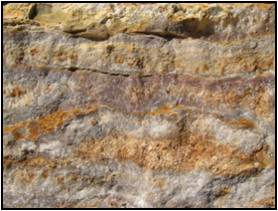 |
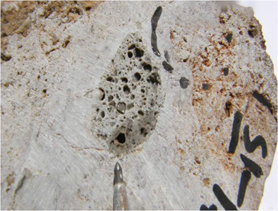 |
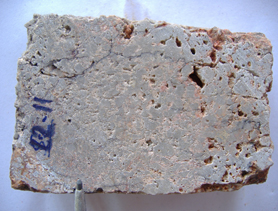 |
|---|---|---|
| A. Crustiform - colloform banded saccharoidal silica | B. Vuggy quartz crystals | C. Quartz-alunite |
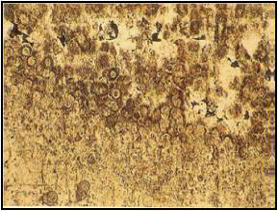 |
 |
 |
| D. Moss texture | E. Mold texture | F. Parallel bladed quartz texture |
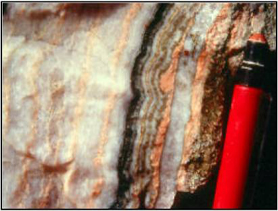 |
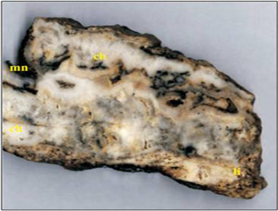 |
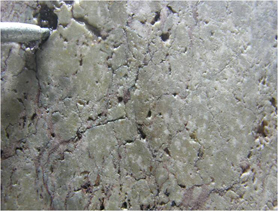 |
| G. Banded vein with chalcedony and adularia | H. Crustiform banding of comb structure | I. Creamy Silica pervasive replacement |
In conclusion, identification of alteration patterns and textures provide valuable information to interpret the nature of the hydrothermal system, ore formation and predict the changes occurred in the past. Therefore, with the inside of alteration modeling vital exploration issues like exploratory drilling, mining technique and direction estimations could be done economically.